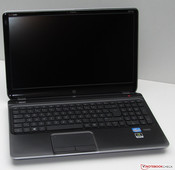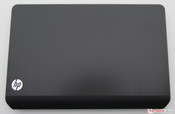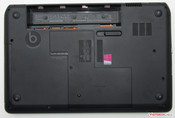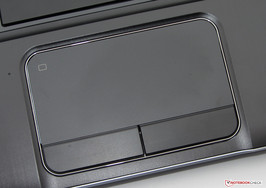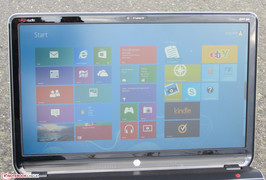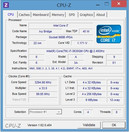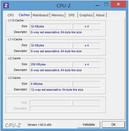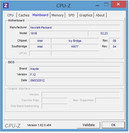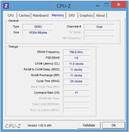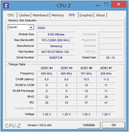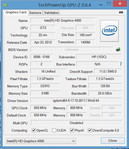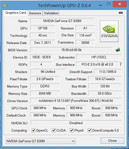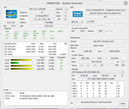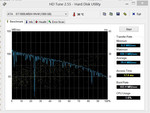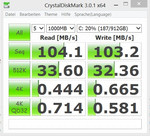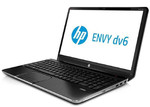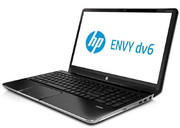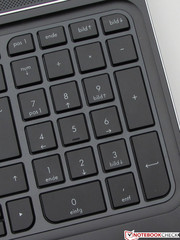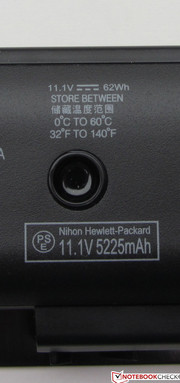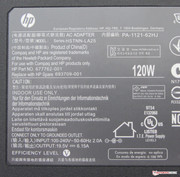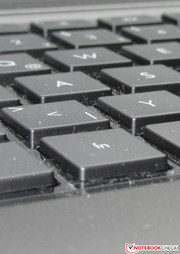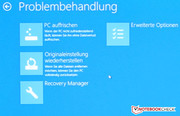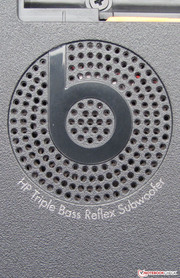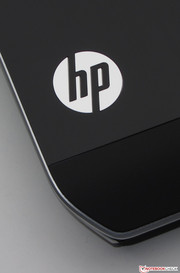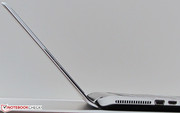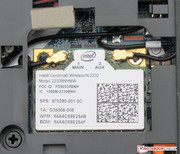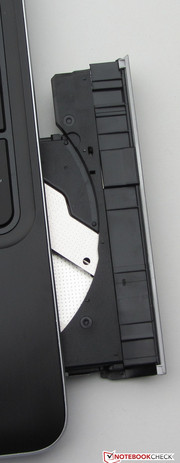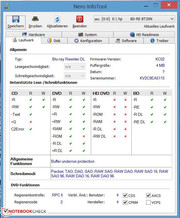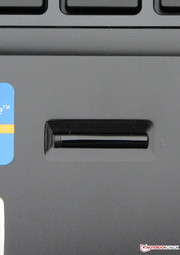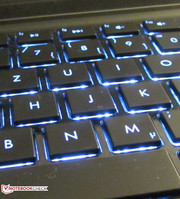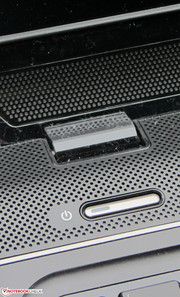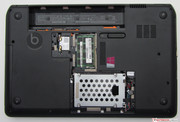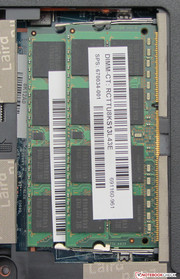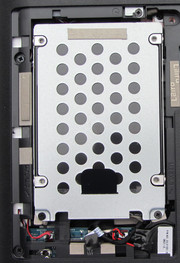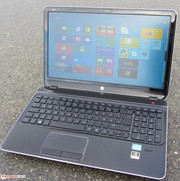Review HP Envy dv6-7202eg Notebook

For the original German review, see here.
The Envy dv6-7202eg is currently the most expensive model (1,200 Euros/~$1571) of a series of new 15.6-inch notebooks in our test parcours. The laptop runs on a quad-core Intel Core i7-3630QM CPU with 16 GB of RAM. Switchable graphics are included: either the Intel HD Graphics 4000 IGP or the Nvidia GeForce GT 630M GPU provides graphics output. The storage device is a 1 TB hard disk and the icing on the cake is a Blu-ray burner.
We will use the Lenovo IdeaPad Y580 (Intel Core i7-3610QM, Nvidia GeForce GTX 660M) and the Asus N56VZ-S4044V (Intel Core i7-3610QM, Nvidia GeForce GT 650M) for comparison so as to give the reader a better understanding of our test model.
Case
Hewlett Packard brings a very attractive model to the market: the Envy dv6. HP has named the color of the laptop: Midnight Black Aluminum. The back of the display cover and the top of the base unit are made of matte aluminum, and the bottom of the laptop is made of matte synthetic material. Sadly, HP did not stick to matte surfaces: the display and the keyboard borders are glossy. A silver-gray synthetic material border around the display and base unit provides a nice contrast to the black of the notebook. The competitors, Lenovo IdeaPad Y580 and Asus N56VZ-S4044V, will not be left behind in terms of looks - in fact, they are partially composed of metal components.
The case of the Envy dv6 is very sturdy and only deforms slightly under pressure. The base of the laptop can be bent a little if the user grabs the front edges and presses. The display cover is quite resistant, and the stiff hinges hold the screen securely in place. It is not possible to open the laptop with one hand.
Connectivity
The connectivity of our test model is similar to that of the Lenovo IdeaPad Y580 and the Asus N56VZ-S4044V. The attentive buyer will notice that the HP model does not use the typical blue USB 3.0 ports. Still, the Envy dv6 is equipped with three USB 3.0 interfaces.
Communication
The Gigabit Ethernet chip of the Envy dv6 originates from Realtek (RTL8168/8111). HP has picked an Intel module for WLAN: the Centrino Wireless-N 2230. This module supports the 802.11 b/g/n WLAN standards. In addition, it also offers Intel's Wireless Display technology, which allows the user to create a connection between the laptop and a certified screen (for example, a home TV) via WLAN. Screens without integrated WLAN modules will require an adapter to use this technology. The required Intel software will be found preinstalled on the dv6.
The Intel module also includes Bluetooth standard 4.0. HP has installed an HD webcam in the display border for VoIP fans and Skype is preinstalled.
Security
A Kensington Lock is included for the security of the model. Furthermore, HP has seen fit to equip the notebook with a fingerprint reader. The reader, paired with HP's SimplePass software, can be used to access the system, or even Internet services.
Accessories
HP demands nearly 1,200 Euros (~$1571) for the Envy dv6-7202eg. This is quite a high price, and that makes it all the more disappointing that the buyer receives few accessories. A few thin manuals are included in the package. We expected at least a DVD of drivers or a Windows 8 installation DVD.
OS and Recovery
HP delivers the Envy dv6 with preinstalled Windows 8 (64-bit). The Recovery partition can be used to reset the notebook to factory settings. Caution: all files and settings created/configured by the user will be deleted. The HP recovery system is easy-to-use: the user has to press F11 at boot to bring it up. Users, who want to swap out the hard disk, should first create an image of the Windows 8 installation. This will permit him/her to easily restore the system on the new hard drive. The necessary software (HP Recovery Manager) is preinstalled on the laptop.
Maintenance
A maintenance flap can be found at the bottom of the HP Envy dv6. This flap covers the hard drive, RAM, WLAN module and BIOS battery of the notebook. Unfortunately, it is not possible to access the fan via this flap. The Envy dv6 uses two RAM slots. Our test model is equipped with 16 GB RAM (2 x 8 GB modules). The laptop cannot support any more RAM. The hard disk can be easily and quickly swapped out for a Solid State Disk.
Warranty
A maintenance flap can be found at the bottom of the HP Envy dv6. This flap covers the hard drive, RAM, WLAN module and BIOS battery of the notebook. Unfortunately, it is not possible to access the fan via this flap. The Envy dv6 uses two RAM slots. Our test model is equipped with 16 GB RAM (2 x 8 GB modules). The laptop cannot support any more RAM. The hard disk can be easily and quickly swapped out for a Solid State Disk.
Input Devices
Keyboard
The HP Envy dv6 uses a chiclet keyboard. The main keys measure 14 x 14 mm (~0.55 x 0.55 inches) and are made of matte black synthetic material. They look very reliable and high-quality. The keys have medium stroke distance and comfortable resistance. The pressure point is clearly noticeable and the keyboard is securely installed in the case. It does not give way under pressure. However, HP was a bit careless in the middle of the keyboard: in this area, the device can be bent inwards slightly and the keyboard does not sit flush at the bottom edge. Although these are small workmanship errors, the buyer cannot tolerate them at a price of 1,200 Euros (~$1571). Overall, we felt that the keyboard is quite good. Nice extra: the wireless module, mute and Caps Lock key each includes a clear LED, which lights up when they are active. Keyboard backlight is also included.
Touchpad
The Synaptics touchpad of the Envy dv6 is placed in a depression. A silver metal border separates it visually and by feel from the rest of the case. The touchpad measures 9.8 x 4.7 cm (~3.86 x 1.85 inches). The smooth surface allows the finger to slide without issues. At the top left edge of the touchpad, we have a switch, which allows the user to turn the touchpad on/off. A small LED shows the status of the touchpad. The device is capable of recognizing multi-touch gestures like zooming with two fingers. The individual gestures can be configured (turned on/off) in the settings menu. Not all functions are on by default; for example, the scroll function is deactivated. The two mouse keys of the touchpad are easy-to-use and have medium stroke distance. The pressure point is tangible.
It appears as if there are some issues between the touchpad and some programs and Windows 8. When certain programs are started (like HWinfo or Hardware Monitor), the touchpad just turns off and cannot be turned back on. This did not occur at each start of the aforementioned programs, but when it did, the issue could only be corrected by restarting the laptop. We circumvented this issue by connecting an external mouse every time the touchpad crashed.
Display
Hewlett Packard uses a matte 15.6-inch display in the Envy dv6-7202eg. The native resolution is 1920x1080 pixels (Full HD). Other models of the Envy dv6 series are only equipped with an HD panel (1366x768 pixels). The Asus N56VZ-S4044V is also equipped with a Full HD panel. The Lenovo IdeaPad Y580 we previously tested used an HD display. However, the laptop was available with a Full HD display as well. The average brightness of the panel of our test model is 257.6 cd/m² - a good number. However, this cannot measure up to the display of the Asus notebook (298.8 cd/m²), but it can beat the Lenovo display (231.4 cd/m²).
| |||||||||||||||||||||||||
Brightness Distribution: 89 %
Center on Battery: 279 cd/m²
Contrast: 537:1 (Black: 0.52 cd/m²)
49.36% AdobeRGB 1998 (Argyll 3D)
67% sRGB (Argyll 3D)
50.7% Display P3 (Argyll 3D)
The display offers good contrast. Our subjective impressions were confirmed by the measurements: the black value of the panel is 0.52 cd/m² and the contrast is 537:1. These values are in good regions. The displays of the Lenovo IdeaPad Y580 (0.46 cd/m², 535:1) and Asus N56VZ-S4044V (0.59 cd/m², 514:1) are similarly good, and prove to even be slightly better. Sadly, the screen cannot cover the sRGB or AdobeRGB color spectrum.
On battery, the brightness of the display does not change, which is promising for outdoor use. The matte display surface and good contrast ensure good outdoor suitability.
The viewing angle stability of the Envy dv6-7202eg is impressive; regardless how the display is turned or looked at; the picture retains its colors to a good extent. The brightness can drop slightly. The displays of the Asus N56VZ and the IdeaPad Y580 can not keep up with the panel of our test model.
Performance
The Envy dv6 series is made up of powerful multimedia notebooks. The performance of the laptops is sufficient for everyday tasks like VoIP, surfing the web, video playback, text editing, etc. Thanks to the good display and potent hardware, our test model can also be used for video editing. The GeForce GT 630M allows the user to enjoy modern games at medium and sometimes high settings.
Currently, the Envy dv6 series includes three models. We are testing the top model of the three, but all three are equipped with the same CPU and GPU. The difference between the models emerges in the RAM quantity, hard disk capacity, the optical drive and the display. The two cheaper models use an HD panel (1366x768 pixels). Thus, the price of the cheapest model is 800 Euros (~$1047).
Processor
Hewlett Packard installs an Intel Core i7-3630QM in the Envy dv6. This is a quad-core CPU from the Intel Ivy Bridge generation. The CPU operates at a clock speed of 2.4 GHz. Thanks to Turbo; the processor can boost the speed of all four cores up to 3.2 GHz. A single-core can be boosted to 3.4 GHz whereas two cores will reach 3.3 GHz.
The CPU finishes the Cinebench tests by running at max speed for most of the time. The single thread tests are performed at 3.2 GHz by all four cores and sometimes at 3.3 GHz by two cores. The multithread tests are completed mainly by all cores operating at 3.2 GHz. Every now and then, the cores slow down to 2.9 to 3.1 GHz. Overall, the Envy dv6 performs at the level of the other two competitors in the CPU tests. In the GL tests, the Asus N56VZ-S4044V (Intel Core i7-3610QM, Nvidia GeForce GT 650M) and the Lenovo IdeaPad Y580 (Intel Core i7-3610QM, Nvidia GeForce GTX 660M) can outperform the HP notebook thanks to their stronger GPUs.
| Cinebench R11.5 - CPU Multi 64Bit (sort by value) | |
| HP Envy dv6-7202eg | |
| Sony SV-S1511X9E/B | |
| Dell XPS 15 (L521X) | |
| MSI GE60-i789W7H | |
| Asus N56VZ-S4044V | |
| Lenovo IdeaPad Y580-20994BU | |
System Performance
The Envy dv6 is fast. Windows 8 boots quickly and the results of the PC Mark 7 benchmark lie neck and neck with the Asus N56VZ-S4044V and the Lenovo IdeaPad Y580. This is to be expected as all three models have similar processors and the same hard disk.
| PCMark 7 Score | 2541 points | |
Help | ||
Storage Device
No user should complain about a lack of storage space in the Envy dv6-7202eg. This laptop is equipped with a hard disk from the Seagate Momentus SpinPoint M8 series. The hard disk has a capacity of 1000 GB/1 TB. The drive operates at 5,400 rpm (rotations per minute). The speeds are good for a 5,400 rpm hard disk. CrystalDiskMark measures a read speed of 104.1 MB/s and HD Tune reports an average transfer speed of 79.4 MB/s. It would be reasonable to expect a Solid State Disk with a capacity of 256 GB in a notebook of this price. This would have accelerated the system further and distanced the model from the competition.
The hard disk is protected by the HP ProtectSmart software and a fall sensor, which will secure the read/write heads in case the drive is dropped, thus preventing damage to the data layer of the hard disk.
Graphics Card
Two GPUs find a home in the Envy dv6: the Intel HD Graphics 4000 IGP and the Nvidia GeForce GT 630M GPU. Depending on the task, the laptop picks the appropriate GPU; while running demanding games, the Nvidia GPU kicks in, whereas the Intel IGP is used to increase battery life. In essence, both GPUs can be used for any task. Which GPU is used when, is decided by the GPU profiles, or Nvidia Optimus. The profiles are delivered with the Nvidia driver. They are regularly updated and can be configured to suit the user's needs.
The Nvidia GeForce GT 630M GPU is a middle-class notebook graphics card which supports DirectX 11. It works at 175 to 797.3 MHz and has 2 GB memory. The Intel HD Graphics 4000 IGP is also DirectX 11-ready. It runs at 350 to 1,100 MHz.
The results of the 3DMark benchmark lie at the expected level. The HP Envy dv6 simply cannot keep up with the Asus N56VZ-S4044V (Intel Core i7-3610QM, Nvidia GeForce GT 650M) or the Lenovo IdeaPad Y580 (Intel Core i7-3610QM, Nvidia GeForce GTX 660M), as their GPUs are more powerful.
| 3DMark 03 Standard | 23373 points | |
| 3DMark 05 Standard | 16709 points | |
| 3DMark 06 Standard Score | 9548 points | |
| 3DMark Vantage P Result | 5567 points | |
| 3DMark 11 Performance | 1278 points | |
Help | ||
| 3DMark 11 - 1280x720 Performance (sort by value) | |
| HP Envy dv6-7202eg | |
| Sony SV-S1511X9E/B | |
| Dell XPS 15 (L521X) | |
| MSI GE60-i789W7H | |
| Lenovo IdeaPad Y580-20994BU | |
| Asus N56VZ-S4044V | |
| 3DMark Vantage - 1280x1024 P Result (sort by value) | |
| HP Envy dv6-7202eg | |
| Sony SV-S1511X9E/B | |
| Dell XPS 15 (L521X) | |
| MSI GE60-i789W7H | |
| Lenovo IdeaPad Y580-20994BU | |
| 3DMark 06 - 1280x1024 Standard Score AA:0x AF:0x (sort by value) | |
| HP Envy dv6-7202eg | |
| Sony SV-S1511X9E/B | |
| Dell XPS 15 (L521X) | |
| Asus N56VZ-S4044V | |
| MSI GE60-i789W7H | |
| Lenovo IdeaPad Y580-20994BU | |
Gaming Performance
Thanks to the Nvidia GeForce GT 630 GPU, the user can indulge in games at medium/high settings. Most games will run fluidly at medium settings and resolution. The same is true for high settings and a lower resolution of 1366x768 pixels. A few demanding games, like Battlefield 3, can push the Envy dv6 to its limits.
| low | med. | high | ultra | |
|---|---|---|---|---|
| StarCraft 2 (2010) | 252.6 | 57.7 | 36.22 | 20.23 |
| The Elder Scrolls V: Skyrim (2011) | 46.82 | 33.8 | 23.88 | 13.46 |
| Mass Effect 3 (2012) | 59 | 42.57 | 25.63 | |
| F1 2012 (2012) | 83 | 76 | 61 | 22 |
Emissions
Noise Emissions
While idle, the Envy dv6 is primarily quiet. We measure noise emissions between 33.5 to 35.2 dB(A). If the Blu-ray drive is used, the emissions rise to 37.4 dB(A).
At full load (stress test - Prime95 and FurMark run simultaneously), the noise emission rises to a distracting 42.7 dB(A). The HP model is still loud at medium load (3D Mark 06 running) and emits 42.5 dB(A). The Lenovo IdeaPad Y580 has similar noise levels as the Envy dv6. The Asus N56VZ-S4044V is better than both as it is much quieter.
Noise level
| Idle |
| 33.6 / 33.8 / 35.2 dB(A) |
| DVD |
| 37.4 / dB(A) |
| Load |
| 42.5 / 42.7 dB(A) |
 | ||
30 dB silent 40 dB(A) audible 50 dB(A) loud |
||
min: | ||
Temperature
If the user just looked at the temperatures on the surface while the laptop is idle, s/he would never realize the powerful hardware underneath. The HP Envy dv6 remains very cool and barely passes the 30 °C (~86.0 °F) mark. We measured temperatures between 24.7 and 30.1 °C (~76.5 and 86.2 °F).
At full load (stress test - Prime 95 and FurMark), the temperatures rise to 26 - 61.7 °C (~78.8 – 143.1 °F). Both the Lenovo IdeaPad Y580 and the Asus N56VZ-S4044V perform better and remain below the levels of the HP model. The hand-rest regions can heat up moderately at load: 35.7 °C (~96.3 °F). Thus, even in this extreme situation, the laptop is comfortable to use.
Our stress test (Prime95 and FurMark run for at least an hour) runs with Turbo CPU and the laptop connected to a power socket. The clock speeds of the individual cores fluctuate between 2.8 and 3.1 GHz. In the following minutes, the core speeds drop to 2.4 GHz, and stay at this level for about 4-5 minutes. The GPU continues to run at full speed (797.3 MHz). The CPU temperature lies at 96 (~204.8 °F). On battery, the CPU can run the stress test with speeds between 1.2 and 2.4 GHz. The GPU runs at 699.5 MHz but occasionally throttles down to 175 MHz.
(-) The maximum temperature on the upper side is 58.2 °C / 137 F, compared to the average of 36.9 °C / 98 F, ranging from 21.1 to 71 °C for the class Multimedia.
(-) The bottom heats up to a maximum of 61.7 °C / 143 F, compared to the average of 39.2 °C / 103 F
(+) In idle usage, the average temperature for the upper side is 26.8 °C / 80 F, compared to the device average of 31.3 °C / 88 F.
(+) The palmrests and touchpad are reaching skin temperature as a maximum (35.7 °C / 96.3 F) and are therefore not hot.
(-) The average temperature of the palmrest area of similar devices was 28.7 °C / 83.7 F (-7 °C / -12.6 F).
Speakers
Hewlett Packard packs four speakers and a subwoofer in this 15.6-inch model. The speakers are placed above the keyboard and the subwoofer can be found at the bottom of the laptop. The "Beats Audio" caption promises high-quality sound output, and the user will not be disappointed with this audio system. The Envy dv6 emanates loud, well-balanced sound. Thanks to the subwoofer, the output includes tangible bass. Overall, HP offers a good audio system, which most notebooks cannot even dream of. However, this Beats audio system is composed of notebook speakers and as such even external speakers, which cost a mere 30 Euros (~$39), should offer better sound quality.
Battery Life
Power Consumption
While idle, the power consumption of the notebook is 9.8 to 15.8 W. These are good values for a laptop with a quad-core CPU and GeForce GPU. At full load (Prime95 and FurMark), the consumption of the Envy dv6 rises sharply to 82.1 W. At medium load (3D Mark 06 running), the laptop is more conservative and requires roughly 80.2 Watts. There is room for higher power consumption, as HP provides a 120 W power adapter. In most cases, the Asus N56VZ-S4044V requires more power than our test model. Only at medium load, are both notebooks at the same level.
| Off / Standby | |
| Idle | |
| Load |
|
Key:
min: | |
Battery Life
While idle, the Envy dv6 has a run time of 7:24 hours (Asus: 6:03 h, Lenovo: 8:02 h). We use the Battery Eater Reader’s test to measure the idle run time. This test will put the brightness to minimum, activate the "Power Saver" Windows profile and switch off all wireless modules. A full battery charge of our test model is depleted after 1:25 hours at full load. The Lenovo IdeaPad Y580 lasts 9 minutes longer and the Asus N56VZ-S4044V quits after 1:57 hours. We used the Battery Eater Classic test to measure the minimum run time. This test sets the brightness to max, activates the "High Performance" Windows profile and turns on all wireless modules.
The WLAN test reflects the run time a user can expect in everyday use. The HP model lasts 4:17 hours (Asus: 3:14 h, Lenovo: 4:26 h). This test runs an automatic script which loads websites every 40 seconds. The "Power Saver" Windows profile is active and the brightness is set to roughly 150 cd/m². Finally, we run a DVD/Blu-ray test to check how the dv6 performs when playing DVDs/Blu-rays. The test model lasts 3:20 and 3:17 hours respectively. The run times of the competitors (Asus: 3:03 h, Lenovo: 3:31 h) in the DVD test are quite close.
Overall, the Envy dv6 can offer good run times for a notebook with a quad-core CPU and a GeForce GPU. The run times of the three notebooks are not directly comparable as they use batteries with different capacities (HP: 62 Wh, Asus: 56 Wh, Lenovo: 68 Wh).
Verdict
Buyers of the HP Envy dv6-7202eg receive a powerful multimedia notebook packed to the brim with modern technology. This laptop can complete any task with ease and look good while doing it. We especially like the high contrast Full HD display with great viewing angle stability and matte surface. The packet will set you back around 1,199 Euros (~$1570) - a high price, but there are alternatives. The other available Envy dv6 models work with the same CPU and GPU but have to cut corners in other areas. The cons of this notebook would be the high noise emissions, which kick in at medium load, and high heat emissions at load.
The Asus N56VZ-S4044V and the Lenovo IdeaPad Y580 are two competitors the buyer can consider, but these two models focus more on games. Their GPUs offer higher frame rates in games than the GPU of the Envy dv6.




